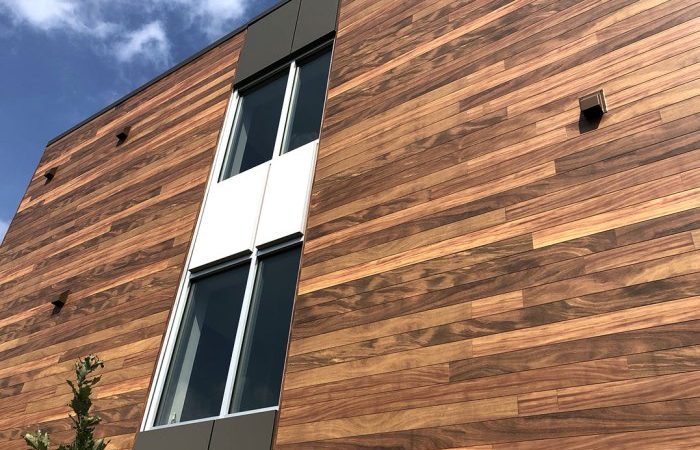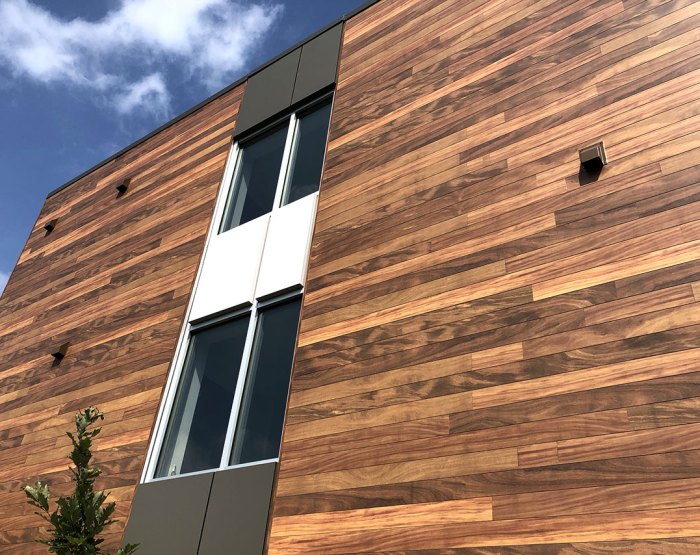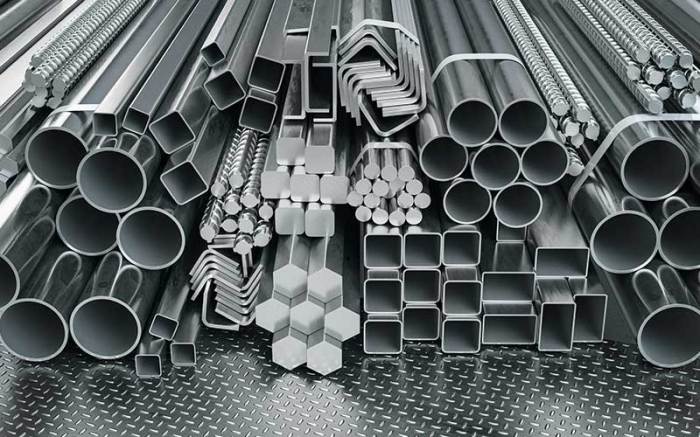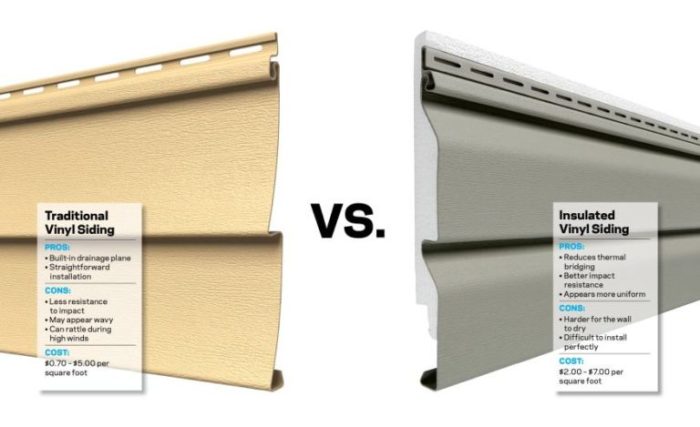Aluminum vs Steel Siding A Homeowners Guide

Aluminum vs steel siding: Choosing the right exterior cladding for your home is a big decision, impacting both aesthetics and longevity. This guide breaks down the key differences between aluminum and steel siding, helping you weigh the pros and cons of each to make an informed choice. We’ll explore cost, durability, appearance, environmental impact, and maintenance, providing a comprehensive comparison to guide your decision.
From initial investment to long-term upkeep, understanding the nuances of each material is crucial. We’ll delve into the specifics, comparing factors like resistance to damage, lifespan under various conditions, and the overall impact on your home’s curb appeal. By the end, you’ll have a clear understanding of which siding best suits your needs and budget.
Cost Comparison

Source: modern-materials.com
Choosing between aluminum and steel siding involves careful consideration of costs, both upfront and over the long term. While initial investment might point towards one material, the total cost of ownership can shift the balance. Understanding these differences is crucial for making an informed decision.
Initial Cost Comparison
The initial cost of siding includes the materials themselves and the labor for professional installation. Prices vary based on several factors, including the quality of the material (e.g., thickness, finish, features), the style of the siding (e.g., horizontal, vertical, shake), and the complexity of the installation (e.g., house size, architectural details). Keep in mind that these are estimates and can fluctuate based on location and contractor.
| Siding Type | Low-Quality Price Range (per sq ft) | Mid-Range Price Range (per sq ft) | High-Quality Price Range (per sq ft) |
|---|---|---|---|
| Aluminum | $2-$4 | $4-$6 | $6-$10 |
| Steel | $3-$5 | $5-$8 | $8-$12 |
Note: Installation costs typically add 30-50% to the material cost. This means a project costing $5,000 in materials might have an overall cost of $7,500 – $10,000 including labor.
Long-Term Cost Comparison
Beyond the initial outlay, long-term costs associated with maintenance, repairs, and eventual replacement significantly impact the overall expense. Steel siding generally boasts a longer lifespan and requires less frequent maintenance than aluminum. However, repairs to steel can be more costly.
| Factor | Aluminum Siding | Steel Siding |
|---|---|---|
| Lifespan | 20-40 years | 30-50 years or more |
| Maintenance | Regular cleaning; occasional repainting | Occasional cleaning; repainting less frequent |
| Repair Costs | Relatively inexpensive for dents and scratches; replacement panels can be costly. | More expensive for significant damage; replacement panels are generally more costly than aluminum. |
| Replacement Cost | Moderate | Higher |
For example, a homeowner might need to repaint aluminum siding every 10-15 years, adding to the long-term cost. Steel siding, while initially more expensive, might require repainting less often, leading to potential savings over the decades. A major hail storm could damage both types of siding, but repairing steel might be more expensive due to its durability. Replacement costs will also reflect the initial cost differences, with steel being significantly more expensive to replace than aluminum.
Durability and Longevity

Source: englertinc.com
Choosing between aluminum and steel siding involves considering their respective strengths and weaknesses regarding longevity and how well they withstand the test of time. Both materials offer considerable durability, but their performance varies depending on factors like climate and maintenance.
Aluminum and steel siding exhibit different responses to impacts, weather exposure, and corrosion. Understanding these differences is key to making an informed decision for your home’s exterior.
Impact Resistance
Aluminum siding is lighter and more flexible than steel. This flexibility can be an advantage in high-wind areas, as it’s less likely to be damaged by strong gusts. However, it’s also more susceptible to dents and scratches from impacts compared to steel siding, which is significantly stronger and more resistant to damage from hail or flying debris. A direct hit from a large hailstone could dent aluminum siding more easily than it would dent steel siding. Similarly, a dropped tool or accidental impact from a ladder would likely cause more noticeable damage to aluminum.
Weather Resistance
Both aluminum and steel siding are designed to withstand various weather conditions. However, their resistance to specific weather elements differs. Aluminum’s excellent corrosion resistance makes it particularly well-suited for coastal areas with high humidity and salt spray. Steel siding, while also corrosion-resistant due to its protective coatings, can be more susceptible to rust in environments with consistently high moisture levels if the coating is compromised. Extreme heat can cause expansion and contraction in both materials, potentially leading to minor warping over time, but this is generally more noticeable in aluminum due to its higher coefficient of thermal expansion. Heavy snowfall, while not directly causing damage, can put stress on siding, particularly if proper ventilation isn’t maintained.
Corrosion Resistance
Aluminum’s natural resistance to corrosion is a significant advantage. Its protective oxide layer prevents rusting, even in harsh environments. Steel siding relies on protective coatings like zinc galvanization or paint to prevent rust. While these coatings are highly effective, they can be damaged over time by impacts or harsh weather, exposing the underlying steel to corrosion. Scratches or chips in the paint of steel siding can lead to rust formation, especially in humid climates. Regular inspection and prompt repainting of damaged areas are crucial for maintaining the longevity of steel siding.
Lifespan and Maintenance
With proper maintenance, aluminum siding can last 50 years or more. Steel siding, when properly maintained, can also last for a similar duration, although its lifespan can be shortened if the protective coating is compromised. Maintenance for both materials involves regular cleaning to remove dirt, debris, and mildew. Aluminum siding may only require occasional cleaning, whereas steel siding might need more frequent cleaning and repainting of damaged areas to prevent rust. Consider the climate; coastal areas with salt spray may require more frequent maintenance for both types of siding, regardless of material. For example, a coastal home experiencing frequent hurricanes might require more frequent inspections and repairs for both aluminum and steel siding due to potential damage from high winds and flying debris. In contrast, a home in a dry, desert climate might require minimal maintenance for either material, except for occasional cleaning.
Appearance and Aesthetics

Source: researchgate.net
Choosing between aluminum and steel siding involves more than just durability; the aesthetic impact on your home’s curb appeal is significant. Both materials offer a wide range of visual options, but their inherent properties influence how they look and feel on a house. Understanding these differences will help you make an informed decision that aligns with your personal style and architectural preferences.
Aluminum and steel siding offer distinct aesthetic qualities that can dramatically alter a home’s appearance. The choice depends heavily on the desired look and feel, considering both color and texture options as well as how the material interacts with different architectural styles.
Color and Texture Variety
Both aluminum and steel siding boast a wide array of color options, allowing for considerable customization. However, the application and resulting texture can vary.
- Aluminum Siding: Typically offers a smoother, more consistent finish. Colors tend to be vibrant and retain their intensity well. Popular textures include smooth, woodgrain, and stucco-embossed finishes. A wide spectrum of colors is available, from classic whites and creams to bold blues, greens, and reds. Some manufacturers even offer custom color matching services.
- Steel Siding: Can achieve a broader range of textures, including those that mimic natural materials like stone or wood with remarkable accuracy. The paint adherence is often superior to aluminum, resulting in longer-lasting color. Steel siding also offers a wider range of colors, but the heavier gauge of steel can sometimes lend a slightly more industrial look, depending on the chosen texture and color.
Siding Material and Architectural Style
The choice of siding material significantly impacts the overall aesthetic of a home, particularly when considered in the context of its architectural style.
| Architectural Style | Aluminum Siding | Steel Siding |
|---|---|---|
| Ranch | A smooth, light-colored aluminum siding can create a clean, modern look. Woodgrain texture can complement the rustic aspects. | Steel siding’s ability to mimic natural materials, like wood or stone, offers flexibility to complement the ranch’s casual style. |
| Victorian | Aluminum siding’s versatility allows for intricate detailing and a variety of colors to capture the Victorian era’s ornate aesthetic. However, achieving the authentic look might require more complex installation. | Steel siding’s ability to mimic textures like wood shakes or shingles offers a more authentic Victorian appearance, particularly with darker colors. |
| Cape Cod | Light-colored aluminum siding with a subtle texture can emphasize the simplicity and charm of a Cape Cod home. | Steel siding in a muted color palette, possibly with a wood-grain texture, complements the traditional aesthetic. |
| Contemporary | Smooth aluminum siding in bold colors or metallic finishes can complement the clean lines and modern aesthetic of contemporary homes. | Steel siding with a sleek, smooth finish or in a dark, matte color can create a sophisticated and modern look. |
Examples of Homes with Aluminum and Steel Siding
Consider a Craftsman-style home. Aluminum siding in a deep green with a woodgrain texture could successfully evoke the natural elements central to the Craftsman style, providing a relatively low-maintenance alternative to real wood. Conversely, a steel siding with a stone-like texture in a warm gray would offer a durable, long-lasting alternative that complements the style’s sturdy build and natural materials. A contemporary home, with its clean lines and minimalist design, might pair exceptionally well with sleek, charcoal-gray steel siding. In contrast, a vibrant blue aluminum siding could provide a bold, modern accent. A traditional colonial home might be best suited to a subtle, cream-colored aluminum siding, while a dark-brown steel siding with a wood-shake texture could offer a more rustic feel.
Environmental Impact
Choosing between aluminum and steel siding involves considering their respective environmental footprints. Both materials have pros and cons regarding manufacturing, transportation, lifespan, and eventual disposal. A comprehensive assessment requires looking at the entire lifecycle of each product.
The environmental impact of aluminum and steel siding is multifaceted, encompassing energy consumption during production, transportation emissions, and end-of-life management. Steel, while often perceived as more environmentally friendly due to its higher recycling rate, has a higher upfront energy demand in its creation. Aluminum, on the other hand, boasts superior recyclability, reducing the need for new material extraction. Understanding these factors helps in making an informed decision aligned with environmental responsibility.
Manufacturing Processes and Energy Consumption
Aluminum production is energy-intensive, requiring significant electricity to extract aluminum from bauxite ore through the Hall-Héroult process. This process involves high temperatures and substantial energy consumption. Steel production, while also energy-intensive, generally requires less energy per unit of material compared to aluminum, especially when using recycled steel. The energy source used for both processes also impacts the overall carbon footprint; using renewable energy sources significantly reduces the environmental burden. For example, a steel mill powered by hydroelectric energy will have a much smaller carbon footprint than one relying on coal.
Transportation Emissions
The transportation of both aluminum and steel siding contributes to greenhouse gas emissions. The distance between the manufacturing facility and the construction site, as well as the mode of transport (truck, train, ship), significantly affects the carbon footprint. Heavier materials like steel generally require more fuel for transportation, leading to higher emissions compared to lighter aluminum siding. However, optimized transportation routes and the use of fuel-efficient vehicles can mitigate these emissions for both materials. Consider a scenario where steel siding is sourced locally, minimizing transportation distances and associated emissions, versus aluminum siding shipped internationally.
Recycling Rates and End-of-Life Management
Aluminum boasts an exceptionally high recycling rate, often exceeding 70% globally. Recycling aluminum requires significantly less energy than producing it from raw materials. Steel also has a high recycling rate, typically around 60-70%, though this can vary by region. Both materials are easily recyclable and can be reused multiple times without significant loss of properties. Proper disposal and recycling programs are crucial to minimize the environmental impact of both aluminum and steel siding at the end of their lifespan. Landfilling these materials should be avoided whenever possible due to the potential for resource waste and environmental contamination.
Energy Efficiency in Buildings
Both aluminum and steel siding can contribute to a building’s energy efficiency, although in different ways. Aluminum’s high reflectivity can reduce heat absorption, potentially lowering cooling costs in warmer climates. Steel siding, while not as reflective, can be designed with insulation backing to improve the building’s overall thermal performance. The choice between these materials depends on the specific climate and the building’s design. For instance, in a hot and sunny climate, aluminum’s reflectivity could be a significant advantage, while in a colder climate, steel with proper insulation might offer better overall energy performance.
Carbon Footprint Assessment
The overall carbon footprint of aluminum and steel siding varies depending on numerous factors, including the sourcing of raw materials, manufacturing processes, transportation distances, and end-of-life management. Life cycle assessments (LCAs) are used to comprehensively evaluate the environmental impact of each material throughout its entire lifespan. While a definitive “winner” is difficult to declare without specific contextual data, LCAs generally indicate that the carbon footprint difference between aluminum and steel siding can be relatively small, with the choice often hinging on the specific circumstances and manufacturing practices involved. Factors such as the use of recycled materials and renewable energy in production significantly influence the final carbon footprint.
Installation and Maintenance
Choosing between aluminum and steel siding involves considering not only initial cost and aesthetics but also the practical aspects of installation and long-term maintenance. Both materials require different skill sets and tools, and their upkeep varies significantly. Understanding these differences is crucial for making an informed decision.
Installation Processes
Aluminum and steel siding installation share some similarities, but key differences exist in terms of handling, cutting, and fastening. Aluminum, being lighter and more malleable, is generally easier to work with for DIYers, while steel’s strength and rigidity may require more experience and specialized tools. Improper installation of either material can lead to issues like leaks, damage, and premature deterioration.
- Aluminum Siding Installation: Typically involves snapping panels together, requiring less precision cutting than steel. It’s lighter weight makes handling easier, reducing strain on the installer. However, its malleability necessitates careful handling to avoid bending or denting.
- Steel Siding Installation: Steel siding often requires more precise cutting and fastening due to its rigidity. The heavier weight necessitates more physical effort and potentially specialized lifting equipment for larger projects. However, its strength provides a more durable and robust final product.
Necessary Tools
The tools needed for each installation differ based on the material’s properties. Having the right tools ensures efficient and safe installation.
- Aluminum Siding: Measuring tape, level, chalk line, tin snips or shears, hammer, drill, self-tapping screws, sealant, safety glasses, work gloves.
- Steel Siding: Measuring tape, level, chalk line, circular saw with metal-cutting blade, nibblers, hammer, drill, self-tapping screws, sealant, safety glasses, work gloves, possibly a helper for heavier panels.
Maintenance Procedures
Regular maintenance extends the lifespan of both aluminum and steel siding. While both are relatively low-maintenance, neglecting cleaning and repairs can lead to costly problems down the line.
- Cleaning: Both aluminum and steel siding benefit from regular cleaning using a garden hose and a soft-bristled brush. For stubborn stains, a mild detergent solution can be used. Avoid abrasive cleaners that could scratch the surface.
- Repair: Minor dents in aluminum siding can sometimes be pushed back into place. Larger damage usually requires panel replacement. Steel siding is more resistant to dents but may require professional repair for significant damage. Both materials benefit from regular inspection for loose fasteners, which should be tightened or replaced.
- Repainting: Aluminum siding is often factory-painted and may not require repainting for many years. If repainting is needed, special aluminum-compatible paints should be used. Steel siding may also require repainting over time, depending on the finish and exposure to the elements. Proper surface preparation is crucial for successful repainting of either material.
Installation Challenges
Installation challenges vary depending on the siding type and the project’s complexity.
- Aluminum Siding Challenges: While generally easier to install, aluminum siding can be easily dented or scratched during handling. Expansion and contraction due to temperature changes can also cause issues if not properly accounted for during installation. Sharp corners and intricate designs can also be challenging to work with.
- Steel Siding Challenges: Steel’s rigidity and weight make it more demanding to install, requiring more experience and potentially specialized tools. Cutting steel requires proper safety precautions to prevent injury. The heavier panels can be difficult to maneuver and install alone.
Maintenance Challenges
Maintenance can present unique challenges depending on the siding material and environmental conditions.
- Aluminum Siding Challenges: Aluminum siding can be susceptible to corrosion in coastal areas or environments with high humidity. Scratches and dents are more visible on lighter colored aluminum siding.
- Steel Siding Challenges: While durable, steel siding can rust if the protective coating is damaged. Repairing significant damage to steel siding can be more expensive than repairing aluminum siding due to the need for specialized tools and techniques. Heavy snow loads can also pose challenges, potentially leading to damage if not properly managed.
Recyclability and Sustainability

Source: sidingauthority.com
Choosing between aluminum and steel siding involves considering not only initial costs and aesthetics but also the long-term environmental impact, particularly concerning recyclability and responsible disposal. Both materials are recyclable, but their processes and associated environmental footprints differ significantly.
Aluminum and steel siding offer distinct advantages in terms of recyclability and sustainability, influencing their overall environmental impact throughout their lifecycle. Understanding these differences is crucial for making an informed decision that aligns with environmentally conscious building practices.
Aluminum Siding Recyclability
Aluminum is highly recyclable, with a remarkably high recycling rate. The material can be melted down and reused repeatedly without significant loss of quality. This means that when aluminum siding reaches the end of its lifespan, it can be effectively recycled into new aluminum products, reducing the demand for newly mined bauxite ore. The energy required to recycle aluminum is significantly less than that needed to produce it from raw materials. For example, recycling aluminum requires only about 5% of the energy needed for primary aluminum production. This contributes to a smaller carbon footprint compared to using virgin materials.
Steel Siding Recyclability
Steel siding is also highly recyclable. Like aluminum, steel can be melted down and reused numerous times without significant degradation. The recycling process for steel is well-established, and scrap steel is a valuable commodity in the steel industry. Recycling steel also consumes considerably less energy than producing new steel from iron ore, minimizing its environmental impact. Estimates suggest that recycling steel saves around 75% of the energy needed for primary steel production. This energy saving translates to a reduction in greenhouse gas emissions.
Environmental Impact of Disposal, Aluminum vs steel siding
Improper disposal of both aluminum and steel siding can contribute to landfill waste and environmental pollution. Aluminum, while recyclable, can leach harmful substances into the environment if not disposed of correctly. Steel, while less prone to leaching, still contributes to landfill volume if not recycled. However, the environmental impact of disposing of these materials is significantly reduced when proper recycling channels are utilized. Landfill space is a finite resource, and recycling helps conserve it.
Responsible Disposal and Recycling Options
Several options exist for responsible disposal and recycling of aluminum and steel siding. Many communities offer curbside recycling programs that accept scrap metal, including aluminum and steel siding. Alternatively, homeowners can transport their old siding to designated recycling centers or scrap yards. Some contractors specializing in siding removal and replacement may also offer recycling services as part of their package. Checking with local recycling facilities or contacting contractors is crucial to determine the best recycling options available in a specific area. It is important to remove any paint or other coatings from the siding before recycling, as these materials can contaminate the recycling process.
Last Point
Ultimately, the best siding material depends on your priorities. Steel offers superior durability and strength, often at a slightly higher upfront cost. Aluminum provides excellent corrosion resistance and is lighter, potentially simplifying installation. Carefully consider your budget, desired aesthetic, climate, and long-term maintenance expectations. By weighing these factors against the information presented, you can confidently choose the siding that best enhances your home’s value and beauty for years to come.
Query Resolution: Aluminum Vs Steel Siding
Can I paint aluminum or steel siding?
Yes, both can be painted, but preparation is key. Aluminum requires a special primer designed for non-ferrous metals. Steel, while more readily paintable, still benefits from proper surface preparation to ensure adhesion.
How do I clean aluminum and steel siding?
Regular cleaning with a pressure washer (low pressure for aluminum) and mild detergent is recommended. Avoid abrasive cleaners that could scratch the surface. For stubborn stains, use a siding cleaner specifically designed for the material.
Which siding is better for coastal areas?
Aluminum’s superior corrosion resistance makes it a better choice for coastal regions with high humidity and salt spray. While steel is also durable, it’s more susceptible to rust in these conditions.
What is the warranty typically offered on aluminum and steel siding?
Warranty lengths vary by manufacturer and product line, but generally range from 20-50 years for both materials. Always check the specific warranty details before making a purchase.
Are there different grades of aluminum and steel siding?
Yes, both aluminum and steel siding come in different gauges (thicknesses) affecting durability and cost. Thicker gauges are more expensive but more durable.
Comments are closed.